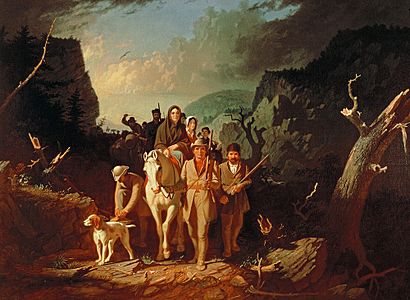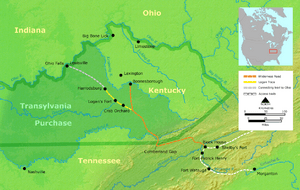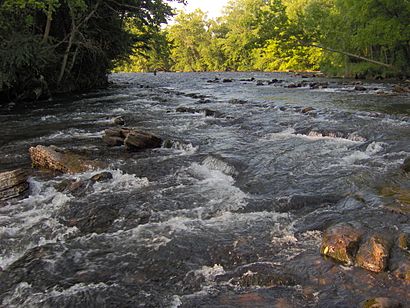Transylvania Colony facts for kids
The Transylvania Colony was a short-lived "colony" started in early 1775. It was created by Richard Henderson, a land speculator from North Carolina. He formed a group called the Transylvania Company. Henderson and his partners made a deal to buy a huge area of land from the Cherokee people. This land was west of the Appalachian Mountains.
The deal was made through a meeting called the Treaty of Sycamore Shoals. The Cherokee leaders who controlled these lands agreed to the sale. In return, the tribes received goods worth about 10,000 British pounds. This land was also claimed by the Virginia Colony and Province of North Carolina.
The Transylvania Colony was located in what is now central and western Kentucky, and a part of north-central Tennessee. A famous American pioneer, Daniel Boone, was hired by Henderson. Boone's job was to create the Wilderness Road. This road went through the Cumberland Gap and into southeastern Kentucky. It helped settlers move into the area.
The settlers created a simple government in May 1775. However, the American Revolutionary War soon began, which stopped most new settlements. Virginia declared Henderson's claim in Kentucky invalid in 1778. North Carolina did the same for the Tennessee part in 1783. Henderson was given other land along the Ohio River in western Kentucky as payment. The town of Henderson was later founded there.
Contents
Why the Colony Started
-
Lord Dunmore's War helped open Kentucky for settlers.
After the French and Indian War, the British government made a rule in 1763. This rule, called the Royal Proclamation of 1763, said that lands west of the Appalachians were "Indian Territory." Colonists were not allowed to settle there.
But explorers and traders kept going into these lands. This led to Native American groups giving up some land for peace. In 1768, the Iroquois signed the Treaty of Fort Stanwix. They gave up their claims to lands south of the Ohio River to Great Britain.
The Iroquois claimed Kentucky, but they didn't live there. The Shawnee and Cherokee also used these lands for hunting. The Shawnee and Cherokee were not part of the Stanwix treaty. The Cherokee later made agreements about borders in 1768 and 1770.
The Shawnee, however, had not agreed to new borders since 1758. They believed all land west of the Alleghenies was theirs. So, they started attacking settlers moving into the area. This led to Lord Dunmore's War in 1774. The Shawnee fought against the Virginia Colony. The Shawnee lost this war. Their chief, Cornstalk, gave up all Shawnee claims south of the Ohio River, including Kentucky.
The Transylvania Company's Plan
On August 27, 1774, Richard Henderson, a judge from North Carolina, started a company. It was a land speculation company. This means they bought land hoping its value would go up. It was first called Richard Henderson and Company. Then it became the Louisa Company. Finally, on January 6, 1775, it was named the Transylvania Company.
The company's investors wanted to create a British "proprietary colony." This was a type of colony owned by a private person or group. They planned to buy the Kentucky lands from the Cherokee. The Cherokee had settled in parts of southern Kentucky and still used the old Shawnee hunting grounds.
Treaty of Sycamore Shoals
In March 1775, Richard Henderson and Daniel Boone met with over 1,200 Cherokee people. The meeting happened at Sycamore Shoals in what is now Elizabethton. Important Cherokee leaders like Attakullakulla and Oconostota were there.
On March 14, 1775, Henderson bought a huge area of land. It was between the Cumberland River, the Cumberland Mountains, and the Kentucky River. It was also south of the Ohio River. This land was about 20 million acres. That's half the size of present-day Kentucky!
Henderson and his partners likely thought this purchase was legal. But it actually broke laws in Virginia and North Carolina. It also went against the Royal Proclamation of 1763. This rule said private groups could not buy land from Native Americans. It also said new colonies could not be started without the British King's permission.
Not all Cherokee chiefs agreed with the treaty. A younger chief named Dragging Canoe refused to sign it. He did not want to follow the Treaty of Sycamore Shoals. Dragging Canoe and his followers moved to southeastern Tennessee. They became known as the "Chickamauga." Dragging Canoe and his group later fought against the Americans in wars.
Building Settlements

Before the Sycamore Shoals Treaty, Henderson hired Daniel Boone. Boone was a skilled hunter. He traveled to Cherokee towns to tell them about the upcoming talks. Boone had explored southeastern Kentucky long before any settlements were built there.
After the treaty, Boone was hired to create the Wilderness Road. This road went from southwestern Virginia, through the Cumberland Gap, and into central Kentucky. Boone and his group faced several Native American attacks while building the trail.
Boone and about thirty workers marked a path to the Kentucky River. There, he built Boonesborough. This settlement was meant to be the capital of Transylvania. Henderson led another group, following Boone's path. They made the path wider so wagons could pass through.
Other settlements like Harrodsburg were also built. Many settlers came to Kentucky on their own. Some of them did not want to follow Transylvania's rules.
When Henderson arrived at Boonesborough, fewer than 100 people lived there. These settlers were in a dangerous place. They faced attacks from Native Americans. They also did not have enough supplies or good shelters.
Despite these problems, Henderson asked the settlers to hold a meeting. This was a constitutional convention. Delegates from different settlements came to Boonesborough. In May 1775, they met for three days under a huge elm tree. They passed nine laws for governing the colony. They also wrote a plan for government called the Transylvania Compact. This plan included a leader, a law-making group, and courts.
The End of the Colony
After the meeting, Henderson went back to North Carolina. He asked the Continental Congress to make Transylvania a legal colony. But the Congress refused. They said they needed permission from Virginia and North Carolina. Both states claimed the land.
In June 1776, Virginia's government said the Transylvania Land Company could not demand anything from settlers. In December 1778, Virginia officially said the Transylvania claim was invalid. As payment, Henderson and his partners received 200,000 acres of land. This land was on the Ohio River. An early settlement there was called Red Banks. It later became the city of Henderson in 1797.
Henderson tried to keep his smaller land claim in Tennessee. But North Carolina also declared it invalid in 1783.
See also
 In Spanish: Transilvania (Norteamérica) para niños
In Spanish: Transilvania (Norteamérica) para niños






